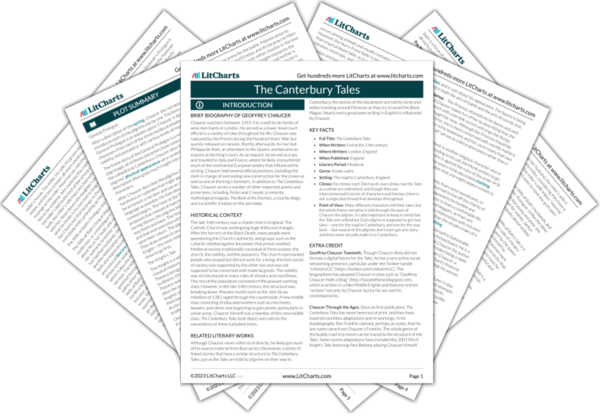Many characters use literary allusions from the Bible and classical mythology. The pilgrims use literary allusions to make themselves seem more authoritative as tale-tellers. Chaucer also uses this effect to enhance the literariness of his Tales and to emphasize his role as the father of English poetry. Sometimes, the effect is serious, as in the Knight’s Tale, when Olympian gods arrive. Often, the effect is comic, as when the rooster Chaunticleer and the hen Pertelote begin quoting classical authors in the Nun’s Priest’s Tale.
Literary Allusions Quotes in The Canterbury Tales
The The Canterbury Tales quotes below all refer to the symbol of Literary Allusions. For each quote, you can also see the other characters and themes related to it (each theme is indicated by its own dot and icon, like this one:
).
The Nun’s Priest’s Tale
Quotes
For al so siker as in principio
Mulier est hominis confusio,––
Madame, the sentence of this Latyn is,
“Womman is mannes joye and al his blis.”
Related Characters:
Chaunticleer (speaker)
Related Symbols:
Literary Allusions
For seint Paul seith that al that writen is,
To our doctrine it is ywrite, ywis;
Taketh the fruyt, and lat the chaf be stile.
Related Characters:
The Second Nun and the Nun’s Priests (speaker)
Related Symbols:
Literary Allusions
Get the entire The Canterbury Tales LitChart as a printable PDF.

Literary Allusions Symbol Timeline in The Canterbury Tales
The timeline below shows where the symbol Literary Allusions appears in The Canterbury Tales. The colored dots and icons indicate which themes are associated with that appearance.
The Wife of Bath’s Prologue
...to the woman at the well with five husbands. Instead, the Wife of Bath interprets Scripture in her own way. She prefers to go forth and multiply, defending her position by...
(full context)
The wise astrologer Ptolemy, says the Wife of Bath, knew best: Ptolemy advises men to mind their own business....
(full context)
The Wife of Bath is upset to learn about Jankyn’s book of wicked wives that he spends his time studying. She tears a leaf out of...
(full context)
The Pardoner’s Tale
...and drinking. The Pardoner launches into a long criticism about their sinful lives, citing many Biblical examples as support. First, he denounces their gluttony, which he says caused the fall of Man....
(full context)
The Nun’s Priest’s Tale
...him. Pertelote chides him, saying that she cannot love such a coward. The Roman philosopher Cato, she says, tells men not to be scared of dreams. She says that the dream...
(full context)
Chaunticleer argues that men of even greater authority than Cato argue that dreams are extremely important. He sites authors who describe premonitions of murders in...
(full context)












